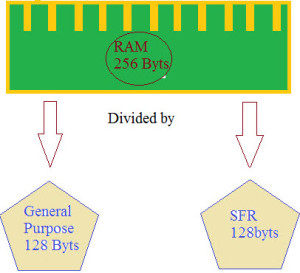Registers in 8051 Microcontroller
Obviously, registers are the keen role in microcontroller process. Why we use these register because it provides a fast way to collect and store a data.
Why registers?
Using microcontroller needs to perform one action whatever it may be that is called as microcontroller process. For instance, I have given one operation to the controller that can't do in the memory. it's a needs a register to manipulate the data, perform the task, process and store. that is register.
A register to say simply, it has a small place in CPU, that can store a small amount of data to perform various operations such as a multiplication, subtraction, addition and division etc.
For instance, we have already a memory why we use these are used for store what it stores.? because it stores the address of the memory location. for every data, we have some memory location that is going to store in the register.
In 8051 family microcontroller RAM have 256 bytes of memory. According to this RAM memory, two types of the register are we have, those are
1. General purpose registers.
2. Special Function Register.
RAM ----- 256 bytes
1. General Purpose Registers --- 128 bytes.
2. Special Function Registers ---- 128 bytes.

In a general purpose register normally has a 4 bank 4 banks of registers,
And in the next podcast, you will let to know pragmatic and rigorous about these types of registers.
Why registers?
Using microcontroller needs to perform one action whatever it may be that is called as microcontroller process. For instance, I have given one operation to the controller that can't do in the memory. it's a needs a register to manipulate the data, perform the task, process and store. that is register.
A register to say simply, it has a small place in CPU, that can store a small amount of data to perform various operations such as a multiplication, subtraction, addition and division etc.
For instance, we have already a memory why we use these are used for store what it stores.? because it stores the address of the memory location. for every data, we have some memory location that is going to store in the register.
In 8051 family microcontroller RAM have 256 bytes of memory. According to this RAM memory, two types of the register are we have, those are
1. General purpose registers.
2. Special Function Register.
RAM ----- 256 bytes
1. General Purpose Registers --- 128 bytes.
2. Special Function Registers ---- 128 bytes.

In a general purpose register normally has a 4 bank 4 banks of registers,
And in the next podcast, you will let to know pragmatic and rigorous about these types of registers.

Comments
Post a Comment